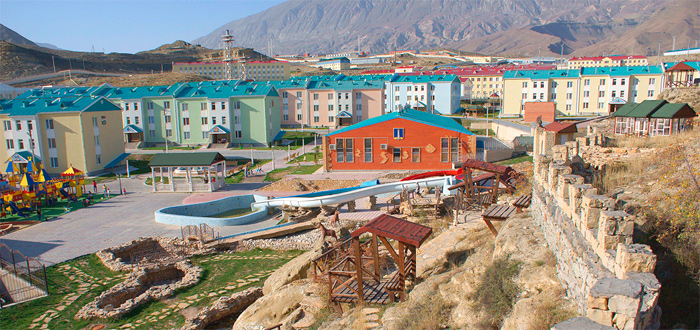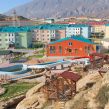
Closure of Dagestani Military Base Reflects Moscow’s Growing Weakness In the North Caucasus
Publication: Eurasia Daily Monitor Volume: 8 Issue: 213
By:

After four years of operation, Russia has been forced to move their military base from Botlikh, Dagestan to Maikop, Adygea. The 33rd mountain infantry brigade will now permanently be stationed in the western part of the North Caucasus (www.yuga.ru/news/243183/). The brigade was located in the mountainous village of Botlikh, which is 252 kilometers southwest of Makhachkala. One of its possible tasks was to march on Georgia, if the need arose.
This military base was set up in 2007, after the large-scale military campaign in Chechnya was over, so it was useless for fighting Chechen militants (https://ingushetia.kavkaz-uzel.ru/articles/127079/). The Russians realized they needed new communications in the Caucasus after Russian-Georgian relations deteriorated. The Botlikh section of a road that had existed since the time of Imam Shamil in the first half of the nineteenth century was selected for this purpose. Then Russian president, Vladimir Putin, visited this base on February 4, 2008, and stated that it “could become a new corridor leading to Georgia” (https://ug.ria.ru/economy/20080204/81645041.html).
There was a historic road that connected the two adjacent territories of Dagestan and Georgia, but during the Soviet period this road was neglected along with many others in the areas along the border between the North Caucasus, on one side, and Georgia and Azerbaijan, on the other. The mountain roads were abandoned largely because highlanders left the mountains en masse and relocated to the plains both in the North and the South Caucasus. As a result of this process, only three roads on Russia’s 1,229 kilometer long border with Georgia and Azerbaijan remain intact – the Military Georgian Road, the Sukhumi Road and the Derbent Road.
Having established a military base manned with an infantry brigade in Botlikh village, high in Dagestan’s mountains, the Russian authorities boasted that they had strengthened their positions in the south of the country. Then-president Putin personally backed this project. The base was designed primarily “to fight terrorists and assist the FSB’s [Federal Security Service] border guards to protect the state border in the North Caucasus from terrorists [and] smugglers, and to disrupt channels for arms, drugs and militant man power supplies” (https://zavtra.ru/cgi//veil//data/zavtra/11/914/print51.html).
Unexpectedly for the Russian military, Chechen leader Ramzan Kadyrov fiercely opposed their plans to use the adjacent Chechen territory as a military training ground for the brigade. The military had planned to make use of Chechen territory extending from the village of Khoi to the village of Makazhoi, which is in the mountainous part of Chechnya’s Vedeno district (www.kavkaz-uzel.ru/articles/121480/?print=true). However, this territory was protected by the federal law on national parks: the area was considered a cultural and natural national reserve that could not become Russian defense ministry property without introducing changes in the law. Not surprisingly, however, the military did not even try to amend the law, given that the Chechen authorities vigorously prosecuted every penetration of the military into this area with lawsuits (www.rg.ru/2008/12/05/reg-kuban/argun.html). It is unlikely that the military was particularly troubled by the lawsuits. It is more likely that Kadyrov’s personal influence and his use of local TV were decisive in preventing the area in Vedeno from being ceded to the military.
Thus the Botlikh base ended up without such a vitally important facility as a training ground. Servicemen from this brigade complained about this unofficially (www.islamnews.ru/news-49501.html). While living in a confined space within the boundaries of the village of Botlikh, the soldiers were forced to train, in the best case, in faraway Adygea. In addition, the Russians failed to upgrade the highways in the mountains, which resulted in poor communications with the plains areas. Every movement of military trucks was likely to cause tensions since they tended to block the narrow roads and impede the seasonal migration of the locals’ cattle from the highlands to the lowlands and back.
The conflict between Botlikh residents and the military started immediately after the latter was allotted land for construction of the infantry brigade base. The military tried to establish better relations with the locals, allocating some positions for them at the base. However, a couple of dozen jobs for Botlikh residents failed to ease the resentment felt by the local population over the loss of their land.
The conflict was further aggravated by the fact that Botlikh residents were limited by the newly enforced border zone rules that restricted the use of land near the Russian-Georgian border. The locals had to apply to the military chief for special permits. Even though there were exceptions made for the local residents, the latter could not understand why they had to ask for permission to go to areas they had freely traveled to during all the previous years. The authorities eventually had to drop their initial rigid 40 kilometer-wide zone along the border and make their border zone restrictions more flexible.
In the end, after several years of struggle, Chechnya’s residents managed to defend the national reserve that had sustained significant damage during the war, when the Russian military intentionally destroyed medieval Chechen monuments (www.ms-chr.ru, October 29). Botlikh residents, for their part, received a well-designed installation for the needs of their town and area, which cost an estimated $500 million (about a third of what the Russian budget allots for culture yearly (https://svpressa.ru/society/article/49768/). In any case, the removal of the military base from Botlikh once again demonstrates the weakness of Russia’s positions in the North Caucasus, with the Russian government seemingly unable to understand where and how many of its servicemen should be stationed in the region.
Another fact that should be noted is that both mountainous infantry brigades – the 33rd in Maikop, Adygea, and the 34th in Zelenchuk, Karachaevo-Cherkessia – are now both based in the western part of the Northern Caucasus. At the same time, however, it is quite plausible that Moscow decided to concentrate military forces in that area to try and reinforce its lines of defense in the run up to the Sochi Olympic Games in 2014.




